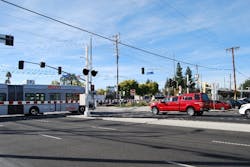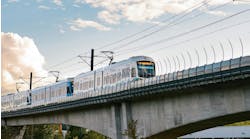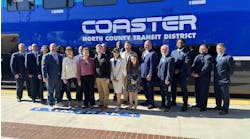L.A. Metro Breaks Ground on Metro Orange Line Improvements Project
The Los Angeles County Metropolitan Transportation Authority broke ground on the Metro Orange Line Improvements Project, which will improve bus speeds and safety, and prepare the bus rapid transit line in the San Fernando Valley for a future conversion to light rail.
Metro has initiated preliminary engineering and has begun taking soil samples near the Sepulveda busway intersection in Van Nuys. The soil samples are part of site investigation work that will better characterize underground soil and ground conditions where the structural supports for aerial bridges are planned to physically separate buses from street traffic below. The project will build two aerial bridges and stations as well as bike and pedestrian path grade separations at Van Nuys and Sepulveda Boulevards – two of the line’s busiest crossings.
Metro will also build four-quadrant crossing gates at up to 35 intersections between North Hollywood and Chatsworth. Other project improvements will include better traffic signal priority technology for buses to improve travel times along the 18-mile corridor.
Taken together, the project could achieve a 20 percent reduction in bus travel times, increase ridership capacity by 39 percent and virtually eliminate the potential for vehicle intrusions onto the busway while improving safety for buses, cars, pedestrians and bicyclists alike.
“I’m happy to see yet another important taxpayer investment designed to improve transportation in the San Fernando Valley,” said L.A. County Supervisor and Metro Board Chair Sheila Kuehl. “Voters clearly want the Metro Orange Line converted to a rail line and these efforts today will help pave the way for its future as an official Metro Rail line.
The $320 to $393 million transit project is funded by L.A. County’s Measure M voter-approved sales tax. Approximately $75 million of the project cost has been made available by SB-1, the state’s gas tax and vehicle fee transportation funding program that was approved by the Legislature and signed into law by Gov. Jerry Brown in 2017.
“SB-1 provides $5.2 billion statewide to fund critically important transportation improvements,” said California Transportation Commissioner and former Los Angeles County Supervisor Yvonne Burke. “We are working with L.A. Metro to invest hundreds of millions in SB-1 funds for several brand new Valley transportation initiatives. These projects will help transform the Valley’s bus and rail offerings, reduce greenhouse gas emissions, vehicle miles traveled and improve overall mobility for Valley residents.”
The project is scheduled in Measure M to be completed by 2025 and is one of the transit projects identified in Metro’s Twenty-Eight by ‘28 list of transportation improvements slated for completion before the arrival of the Olympic and Paralympic Games in Los Angeles.
Metro is now working closely with the city of Los Angeles to test four-quadrant gates for a BRT application like the Orange Line. The pilot gate will be located at the city of Los Angeles Bureau of Street Services crossing that is approximately 300 yards east of Sepulveda Boulevard and will be completed in winter 2019.
“The Metro Orange Line accommodates the highest number of bus riders in the San Fernando Valley,” said L.A. City Council Member and Metro Board Member Paul Krekorian. “This and other planned Valley transit improvements will go a long way toward achieving the kind of integrated public transit system that Valley residents overwhelmingly approved as part of Measure M.”
In conjunction with the pilot gates, a traffic impact analysis is being conducted with the Los Angeles Department of Transportation to evaluate potential impacts of crossing gates on traffic along the Orange Line corridor and to ensure that the proposed gating system meets desired speed improvements while minimizing delays for Valley cross traffic.
“We are now delivering on our agency’s promise to dramatically improve transit services, whether you’re traveling in the San Fernando Valley or throughout Los Angeles County,” said Metro CEO Phillip A. Washington. “In doing so, we are leveraging both local and state funding to build the Valley’s transit future as quickly as possible.”
Metro will coordinate the project’s future connections in Van Nuys or Sepulveda with other planned transit projects, including the Sepulveda Transit Corridor Project and the East San Fernando Valley Transit Corridor Project. Other planned transit projects in the area include the North San Fernando Valley Bus Rapid Transit Project, the North Hollywood to Pasadena Bus Rapid Transit Corridor Project and the 2020 electrification of all buses on the Orange Line.
Metro began its technical study for the project less than a year after voter approval of the Measure M transportation measure in 2016. The Metro Board approved project recommendations this summer.
The Orange Line is planned to be converted to light rail by 2057 unless it can be delivered sooner via a Metro public-private partnership.




